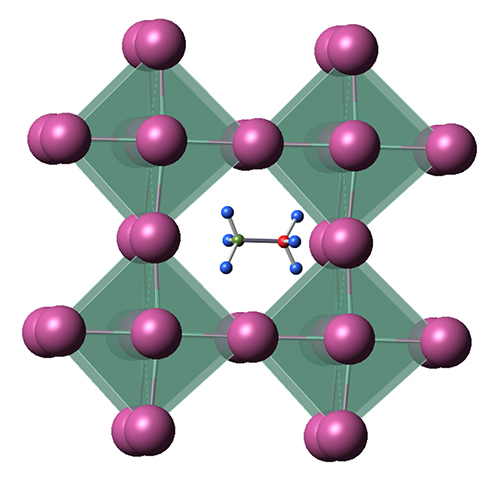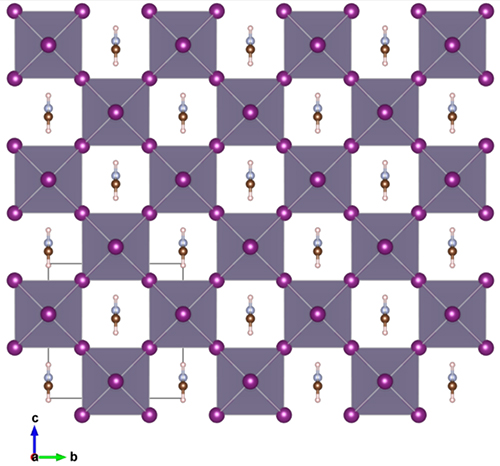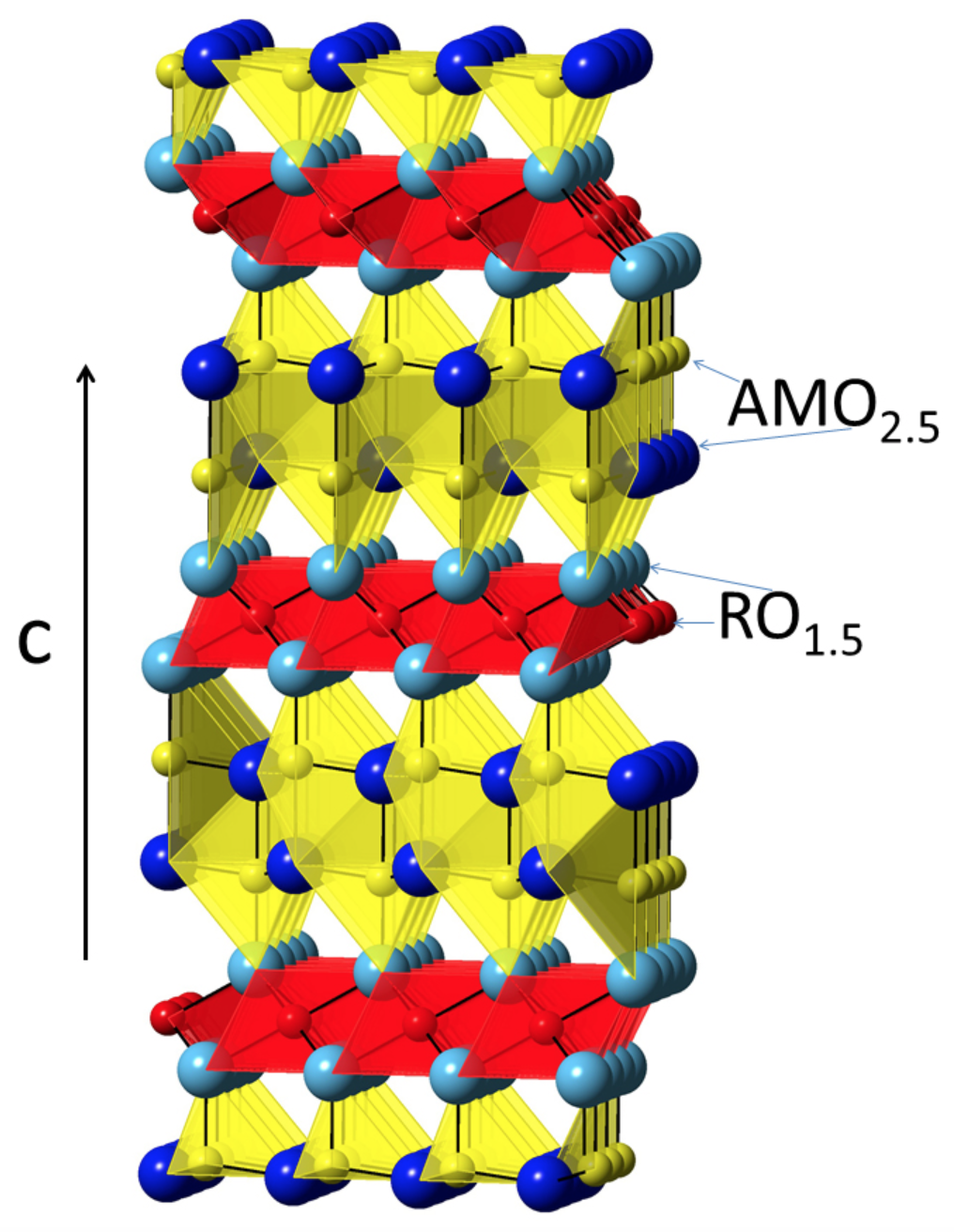RESEARCH PROJECTS
 Polycrystalline InAs based materials are potential candidates for low cost wafer-scale detector applications due to their excellent optical properties. However, grain boundaries (GBs) in polycrystalline InAs are very challenging to eliminate and are expected to have a profound effect on the electronic properties of the material and the device efficiency. Thus, an in-depth understanding of the electronic structure of the GBs in InAs and of the role played by the passivation mechanisms is required. We employ first-principles density functional approach to investigate the electronic, structural, and transport properties of GBs in InAs. In particular, we study the energetics and passivation mechanisms of GBs to calculate their relative stability and experimental feasibility. Understanding the exact nature of the GB electronic structure as well as their passivation mechanism is a key step for the further development of wafer-scale InAs based devices.
Polycrystalline InAs based materials are potential candidates for low cost wafer-scale detector applications due to their excellent optical properties. However, grain boundaries (GBs) in polycrystalline InAs are very challenging to eliminate and are expected to have a profound effect on the electronic properties of the material and the device efficiency. Thus, an in-depth understanding of the electronic structure of the GBs in InAs and of the role played by the passivation mechanisms is required. We employ first-principles density functional approach to investigate the electronic, structural, and transport properties of GBs in InAs. In particular, we study the energetics and passivation mechanisms of GBs to calculate their relative stability and experimental feasibility. Understanding the exact nature of the GB electronic structure as well as their passivation mechanism is a key step for the further development of wafer-scale InAs based devices.
Altynbek Murat, Masahiko Matsubara, and Enrico BellottiFirst-principles Investigation of Grain Boundaries in InAsMRS Fall Meeting 2017. Boston, MA, USA (Nov 29, 2017)
Altynbek Murat, Masahiko Matsubara, Binh-Minh Nguyen, and Enrico BellottiModeling of Grain Boundaries in InAsThe II-VI Workshop, Chicago, IL, USA (Nov 1, 2017)
Hybrid Perovskites
 Hybrid organic-inorganic perovskite solar cells have recently emerged as the next-generation photovoltaic technology. Most of the work has been focused on the prototype MAPbI3 perovskite (MA= Methylammonium = CH3NH3+) and its analogues that have lead to power conversion efficiencies in excess of 15%. Despite the huge success, these materials are still non-optimal in terms of optical absorption as the bandgaps are ~1.6 eV and greater.
Hybrid organic-inorganic perovskite solar cells have recently emerged as the next-generation photovoltaic technology. Most of the work has been focused on the prototype MAPbI3 perovskite (MA= Methylammonium = CH3NH3+) and its analogues that have lead to power conversion efficiencies in excess of 15%. Despite the huge success, these materials are still non-optimal in terms of optical absorption as the bandgaps are ~1.6 eV and greater.

Thus, investigation and development of perovskites with bandgaps closer to optimal, allowing enhanced spectral absorption, is of great interest. The aim of this project is to perform first-principles calculations to study the structural, optical, and electronic properties of new derivatives of MAPbI3 in which the organic MA cation is replaced by other organic amines of similar size and/or the Pb cation is replaced by similar elements.
Altynbek Murat and Udo SchwingenschlöglFirst-principles investigations of lead-free formamidinium based hybrid perovskitesAPS March Meeting, San Antonio, TX, USA (March 2-6, 2015)
Quantum Transport in 2D Heterostructures
 Electronic and quantum
transport properties of 2D heterostructures, both in-plane and out-of-plane configurations, will be investigated using first-principles self-interaction corrected
density functional theory combined with the non-equilibrium
Green’s function method primarily for sensing chemical and biological species. In particular, we will simulate the current-voltage (I-V) characteristics of the sensor and characterize the conductance for
different layers/stacks of 2D heterostructures. Different configurations based on superlattices would provide tailored electronic and optical properties required for variety of sensing applications. Our systematic investigation would provide critical insight in understanding the fundamental working principles of 2D sensors as well as to help in the development of nanoscale sensors with high sensitivity and selectivity.
Electronic and quantum
transport properties of 2D heterostructures, both in-plane and out-of-plane configurations, will be investigated using first-principles self-interaction corrected
density functional theory combined with the non-equilibrium
Green’s function method primarily for sensing chemical and biological species. In particular, we will simulate the current-voltage (I-V) characteristics of the sensor and characterize the conductance for
different layers/stacks of 2D heterostructures. Different configurations based on superlattices would provide tailored electronic and optical properties required for variety of sensing applications. Our systematic investigation would provide critical insight in understanding the fundamental working principles of 2D sensors as well as to help in the development of nanoscale sensors with high sensitivity and selectivity.
Chieh-Szu Huang, Altynbek Murat, Vasudeo Babar, Enrique Montes, and Udo SchwingenschlöglAdsorption of the Gas Molecules NH3, NO, NO2, and CO on Borophene
Carbon Nanotube Gas Sensors
 Carbon nanotubes (CNTs) have a wide range of applications in transistors, spintronics, sensors, and solar cells. Due to their “quantum nature” and high surface-to-volume ratio, they are considered as promising candidates for extremely sensitive gas sensors. However, the gas sensing response of pristine CNTs is weak due to the strong sp2 bonds of the carbon network, characterized by a low chemical reactivity. Thus, functionalization of the CNT surface is necessary to obtain a gas sensor with high sensitivity and selectivity. Covalent molecular bonding to nanoscale objects usually is an efficient way to alter the object conducting properties. This is the key concept behind a new generation of nanotube/nanowire based chemical and biological sensors. Most of the complexity in addressing these systems theoretically stems from the size of the simulations. Here we simulate the current-voltage (I-V) characteristics of large sensors
Carbon nanotubes (CNTs) have a wide range of applications in transistors, spintronics, sensors, and solar cells. Due to their “quantum nature” and high surface-to-volume ratio, they are considered as promising candidates for extremely sensitive gas sensors. However, the gas sensing response of pristine CNTs is weak due to the strong sp2 bonds of the carbon network, characterized by a low chemical reactivity. Thus, functionalization of the CNT surface is necessary to obtain a gas sensor with high sensitivity and selectivity. Covalent molecular bonding to nanoscale objects usually is an efficient way to alter the object conducting properties. This is the key concept behind a new generation of nanotube/nanowire based chemical and biological sensors. Most of the complexity in addressing these systems theoretically stems from the size of the simulations. Here we simulate the current-voltage (I-V) characteristics of large sensors
Altynbek Murat, Ivan Rungger, Stefano Sanvito, and Udo SchwingenschlöglAuCl4 functionalized carbon nanotubes: origin of the p-type dopingAPS March Meeting, San Antonio, TX, USA (March 2-6, 2015)
Altynbek Murat and Udo SchwingenschlöglFirst-principles investigations of nanoscale sensors based on functionalized CNTs4th Annual KICP Research Symposium, KAUST, KSA. April 29, 2014
Altynbek Murat, I. Rungger, S. Sanvito, and U. SchwingenschlöglOrigin of the p-type character of AuCl3 functionalized CNTsMRS Spring Meeting. San Francisco, CA, USA. April 22, 2014
Nanoscale Sensors in Realistic Conditions
 Carbon nanotubes (CNTs) have a wide range of applications in transistors, spintronics, sensors, and solar cells. Due to their “quantum nature” and high surface-to-volume ratio, they are considered as promising candidates for extremely sensitive gas sensors. However, the gas sensing response of pristine CNTs is weak due to the strong sp2 bonds of the carbon network, characterized by a low chemical reactivity. Thus, functionalization of the CNT surface is necessary to obtain a gas sensor with high sensitivity and selectivity.
Carbon nanotubes (CNTs) have a wide range of applications in transistors, spintronics, sensors, and solar cells. Due to their “quantum nature” and high surface-to-volume ratio, they are considered as promising candidates for extremely sensitive gas sensors. However, the gas sensing response of pristine CNTs is weak due to the strong sp2 bonds of the carbon network, characterized by a low chemical reactivity. Thus, functionalization of the CNT surface is necessary to obtain a gas sensor with high sensitivity and selectivity.
Altynbek Murat and Udo SchwingenschlöglThe Effect of Water on the Conductivity of Gas SensorsKAUST-NSF International Conference, KAUST, KSA (March 16, 2016)
Altynbek Murat, Ivan Rungger, Stefano Sanvito, and Udo SchwingenschlöglMechanism of H2O induced conductance changes in AuCl4 functionalized CNTsPsi-k 2015 Conference, San Sebastian, Spain (September 6-10, 2015)
Altynbek Murat, Ivan Rungger, Stefano Sanvito, and Udo SchwingenschlöglMechanism of H2O induced conductance changes in AuCl4 functionalized CNTsAPS March Meeting, San Antonio, TX, USA (March 2-6, 2015)
Nanoparticles
 The current demand for a large-scale renewable energy source has resulted in an increased interest in photovoltaic technologies. Quantum dot (QD) nanoparticles are receiving significant attention due to their potential use in next-generation photovoltaic devices, as well as LEDs, electronic and optoelectronic devices, field effect transistors (FETs), and biological sensors. Attractive characteristics such as high fluorescence quantum yield, high molar extinction coefficient, ease of solution processing, and size-dependent band gap make quantum dot nanoparticles a desirable candidate for the sensitization of large band gap metal oxides (MO) such as TiO2 (3.2 eV), SnO2 (3.8 eV), and ZnO (3.2 eV) to visible light. One of the remaining challenges in achieving high efficiency devices is a better understanding of the electron transfer dynamics at the QD − MO interface and the subsequent optimization of the method of sensitizer deposition based on this understanding.
The current demand for a large-scale renewable energy source has resulted in an increased interest in photovoltaic technologies. Quantum dot (QD) nanoparticles are receiving significant attention due to their potential use in next-generation photovoltaic devices, as well as LEDs, electronic and optoelectronic devices, field effect transistors (FETs), and biological sensors. Attractive characteristics such as high fluorescence quantum yield, high molar extinction coefficient, ease of solution processing, and size-dependent band gap make quantum dot nanoparticles a desirable candidate for the sensitization of large band gap metal oxides (MO) such as TiO2 (3.2 eV), SnO2 (3.8 eV), and ZnO (3.2 eV) to visible light. One of the remaining challenges in achieving high efficiency devices is a better understanding of the electron transfer dynamics at the QD − MO interface and the subsequent optimization of the method of sensitizer deposition based on this understanding.
- QD Surface Chemistry & Modifications
- Ligand Effects: Linker Molecules
- Electron Transfer Reactions at the QD-Metal Oxide Interface
Complex Transparent Conducting Oxides (TCOs)
 Transparent conducting oxides (TCOs) are unique materials that exhibit high optical transparency in the visible region and controllable nearly-metallic electrical conductivity. The range of technological applications and devices which use TCO as a vital component, is remarkable: it includes flat panel displays, electrochromic and smart windows, photovoltaic cells, and invisible transparent electronics.
Transparent conducting oxides (TCOs) are unique materials that exhibit high optical transparency in the visible region and controllable nearly-metallic electrical conductivity. The range of technological applications and devices which use TCO as a vital component, is remarkable: it includes flat panel displays, electrochromic and smart windows, photovoltaic cells, and invisible transparent electronics.
Until recently, much of the research work and development in the TCO field has been primarily limited to optimizing and improving the performance of conven- tional binary n-type TCOs. However, high worldwide demand for TCO-based technological devices, as well as rapid development of novel TCO-based applications, stimulated the search for alternative TCO materials, those that are more efficient, cost effective, and have broader range of both electrical and optical properties. As a result, a variety of novel TCO materials with optical and electronic properties controllable via chemical composition has been introduced. The novel TCOs include the complex multicomponent TCOs such as InGaZnO4. The main advantage of the multicomponent TCOs is the ability to offer a wide range of tunable electrical and optical properties. These properties include band gaps, band offsets, carrier concentrations, and carrier transport that can be benefitted by a variety of TCO-based applications, such as high performance solar cells and invisible electronics. In addition, multicomponent oxides offer a chance to go beyond the conventional oxides in their compositions, by utilizing the cheap and abundant light-metal oxides.
In this project, first-principles density functional approach is employed to investigate the structural, optical, and electronic properties of several (un)doped (non)stoichiometric multicomponent oxides with layered structure such as InGaZnO4 as candidates for novel transparent conducting oxides. The structural and compositional complexity of these multi-cation materials requires in-depth understanding of the complex defect chemistry in order to determine the carrier source(s). We systematically calculate the formation energies and transition levels of possible acceptor and donor point defects as well as the implied defect complexes and determine the equilibrium defect and electron densities as a function of growth temperature and oxygen partial pressure. We proposed a carrier generation mechanism explaining the observed intriguing behavior of the conductivity in InGaZnO4.
Altynbek MuratComplex oxides as novel transparent conductors (invited talk)UAE University, Al-Ain, Abu Dhabi, UAE. Feb, 2013
Altynbek Murat and Julia E. MedvedevaAb-initio investigations of complex oxidesAPS March Meeting, Dallas, TX. USA. 2011
Altynbek Murat and Julia E. MedvedevaSystematic first-principles investigations of multicomponent main group metal oxidesMRS Fall Meeting. Boston, MA. USA. 2010
My Research Toolbox
Research Methods:
- Density Functional Theory (DFT)
- Molecular Dynamics (MD)
- NEGF
DFT Softwares & Packages:
- VASP
- SIESTA
- SMEAGOL
- QUANTUM Espresso
- FLAPW
- LMTO
- Dmol3
- LAMMPS
- NAMD
Scientific Applications:
- MATLAB
- Mathematica
- MathCad
- COMSOL Multiphysics
- Materials Studio
- MedeA
Programming:
- Python
- Git
- Fortran
- Shell/Bash
- LaTeX
Data Visualization & Analysis:
- VESTA
- Xmgrace
- CrystalMaker
- Avogadro
- Xcrysden
- Ymol
- Matplotlib
- Xfig
- OriginPro
- GDIS
- VMD



